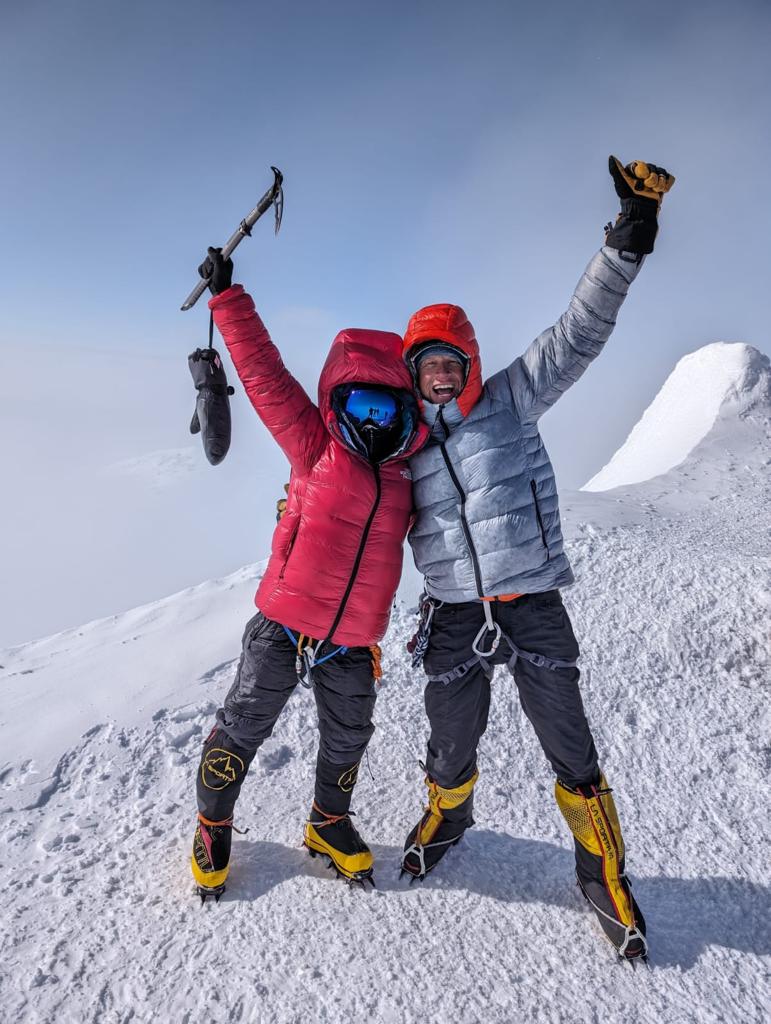Sidley is a huge mountain, set on the white expanse of the Polar Ice Sheet. This majestic peak features a 3 mi (5 km) wide caldera and sheer-walled amphitheater, created by an explosive eruption 4.7 million years ago. Blue-ice slopes guard the upper mountain and fantastical snow mushrooms sprout along the upper ridge, leading to the summit.
Mount Sidley was first climbed in 1990 by New Zealander Bill Atkinson.
photo credits: Tre-C Dumais, Scott Woolums, Dylan Taylor, Russ Hepburn
- Itinerary
- Dates and Costs
- Gear List
- Why Madison Mountaineering?
Day 1: Arrive in Punta Arenas, Chile. Our guide will meet you upon arrival at the airport and take you to our hotel. After settling in, we will conduct a thorough equipment check, and then have a group dinner at one of the many fine restaurants.
Days 2-3: COVID-19 mitigation protocol days in Punta Arenas to ensure the well-being of team members and staff and to minimize the risk of bringing the infection into Antarctica.
Day 4: After breakfast, we attend a pre-flight briefing with our flight operator, and discuss many aspects of the journey to Antarctica. In the afternoon we send our duffel bags to the airport to be checked and packed for departure. We have the late afternoon and evening to explore the city.
Day 5: Depart for Antarctica. We fly approximately 4 hours over the Drake Passage and land at Union Glacier camp. We generally spend 1-2 nights at this camp.
Day 6: Review rope travel, Ice axe arrest, and crevasse rescue techniques.
Day 7: Fly to Mount Sidley base camp, establish base camp.
Days 8-14: Climbing period. Mount Sidley has been climbed by fewer than 10 teams and there is still opportunity for exploring new routes. The mountain offers several interesting options, including a longer, easy ascent from the north side and a steeper climb up the west ridge from the Bennett Saddle. Your guide will assess the options and decide on a route based on the group’s skill and experience.
From base camp to the summit of Mount Sidley involves approximately 7300 ft (2225 m) of elevation gain. You’ll climb alpine-style, setting intermediate camps on the mountain, and carrying all of your food and equipment with you. Although you may use skis lower down on the mountain, most of the climb will be done with crampons.
The slopes of the mountain are wind-blown, with hard packed snow and sections of blue-ice. Gentle slopes near the base give way to steeper terrain higher up.
Summit day offers spectacular views as you follow up the summit ridge along the rim of the caldera. The walls of the Weiss Amphitheater drop steeply away below you and neighboring Mount Waesche may tempt you with its snowy slopes.
As you make your way to the summit ridge, you’ll weave your way between a fantastical maze of snow mushrooms. These massive snow features are formed by wind and moisture depositing rime ice on small obstacles over time.
Following the summit, you’ll return to your high camp, then retrace your steps back to base camp.
Day 15: Fly back to Union Glacier Camp this day.
Day 16: Fly from Union Glacier Camp to Punta Arenas
Day 17: Sightseeing and preparations to return home from Punta Arenas.
Day 18: Depart Punta Arenas for home.
Days 19-23: Extra days in case of bad weather or flight delays – we strongly recommend booking a changeable return flight for ~5 days after the scheduled departure day (Day 18) to accommodate any unexpected expedition itinerary delays.
Mount Sidley climb
- TBD
Deposit: USD 12,000
Costs Include:
- Round trip flights from Punta Arenas to Antarctica
- All flights within Antarctica to reach Mount Sidley base camp and back
- All accommodation and services while in Antarctica
- All meals in Antarctica
- All team equipment (tents, ropes, cooking equipment, etc.)
- All communications equipment such as VHF radios and satellite phone
- Guide service fees
- Daily weather forecasting during the climb
Costs Do Not Include:
- Bank transfer fees, if needed
- Accommodation and meals in Punta Arenas
- Personal items (see equipment list)
- Medical and Evacuation Insurance (required)
- Trip cancellation insurance (highly recommended)
- Any charges incurred that are beyond the control of Madison Mountaineering
- All prices and program dates are subject to change
Cancellation/Refund Policy
- There are no refunds for the deposit or balance payments for this expedition. This includes but is not limited to, expeditions that conclude without reaching or making progress towards expedition objective(s) (for example, the summit) due to route conditions, weather, insufficient manpower, or any other factor outside the control of Madison Mountaineering.
- Expedition leader has the final say on the expedition conclusion and will make all best efforts towards reaching expedition objective(s) within our margin of safety.
- Participants that choose to leave an active expedition for any reason are not entitled to any refunds
- Madison Mountaineering, LLC highly recommends trip cancellation insurance for all expeditions
- Due to the nature and heavy costs of government and operator permits, Madison Mountaineering must adhere to a stringent refund policy
- Deposit due with registration materials
- All balances are due 120 days prior to departure date unless otherwise specified
- Participants whose balances are not received by the 120-day deadline as stated above, risk forfeiture of their funds and their place on the expedition
Note: Madison Mountaineering, LLC reserves the right to waive any fees. As we offer personalized service, we will attempt to accommodate changes and cancellations when necessary, waiving certain fees when feasible. Deposits paid by participants acknowledge the above cancellation terms.
Base Layers
- Synthetic Short Underwear (4 pair): non-cotton style underwear
- Lightweight Long Underwear (2 pair): long sleeve shirt and long pants
- Heavyweight Long Underwear (2 pair)
- Short Sleeve Synthetic Shirt (1-2)
Mid Layers
- Soft Shell Jacket: to be worn over other layers
- Soft Shell Pants: very breathable and water repellant
- Mid-Layer Top: lightweight layer for use over base layers
- Lightweight Nylon Pants (1-2 pair)
Windproof/Rain Layers
- Hard Shell Jacket with hood: waterproof and breathable shell jacket
- Hard Shell Pants: waterproof and breathable shell pants
Insulation Layers
- Heavyweight Insulated Down Jacket with hood
- Insulated Pants
Headwear
- Warm Hat: synthetic or wool hat (ski hat)
- Balaclava: to protect your neck and face in high winds
- Baseball Cap or other sun hat: to shade your face/neck from the sun on a hot day
- Bandana or Buff: to protect your neck/face from the sun
- Facemask: neoprene type
- Nose Guard (optional): sun protection for nose
Eyewear
- Glacier Glasses: full protection with side covers or wrap around
- Ski Goggles: to be worn in the event of high winds – (2 Pair)
Gloves
- Lightweight Synthetic Base Layer Gloves (2 pair): for wearing on warm days
- Soft Shell Gloves: to wear for moderate cold/wind
- Shell Glove with Insulated Liner: to wear for severe cold/strong wind
- Expedition Mitts: large enough to fit a liner glove inside
- Heated Gloves (optional): battery-powered heated gloves
Footwear
- Liner Socks (3 pairs)
- Wool or Synthetic Socks (3 pairs)
- Mountaineering Boots
- Camp Boots: warm comfortable boots for wearing in camp
- Booties (optional)
Sleeping Equipment
- Sleeping Bag: -40°F
- Self-inflating Sleeping Pad: full length is preferred
- Closed-cell Foam Pad: to be used in conjunction with the inflating pad for warmth and comfort when sleeping
- Earplugs
Mountaineering Gear
- Expedition Backpack: 80L +
- Compression Stuff Sacks: for reducing the volume of the sleeping bag, down parka, etc. in your pack
- Trash Compactor Bags: to line backpack and stuff sacks as well as for separating gear
- Trekking Poles with Snow Baskets: adjustable
- Ice Axe: general mountaineering tool (65cm)
- Ice Axe Leash: harness style, not wrist style
- Crampons: general mountaineering crampons
- Climbing Helmet: must be able to fit over your warm hat
- Ascender: 1 right or left-hand ascender
- “Y” Rig for ascender and safety carabiner
- Accessory Cord: 30 feet (9m) of 6mm accessory cord
- Alpine Climbing Harness: mountaineering harness, with adjustable leg loops. Not a rock-climbing “sport” harness
- Carabineers: 4 regular, 2 standard locking, 2 large locking for use with harness
- Belay/Rappel Device
- Headlamp: with 2 extra sets of new batteries
- Sled Duffle Bag: 150L expedition duffel bag used to transport all gear on your sled; must be waterproof and durable
Travel Items
- Small Duffel Bag with Lock: to store items in the hotel(s) while on the climb
- Carry-on Backpack: approximately 18” x 16” x 10” (46cm x 41cm x 26cm)
- Travel Clothes and Shoes: for days in cities and towns
- Lightweight journal, sketchbook, pencils, pen
- U.S. cash: for currency exchange to purchase SIM cards or merchandise in cities and towns
Additional Food Items
- Snack food: bring a few days’ supply of your favorite climbing snack food such as bars, gels, nuts, beef jerky, etc. variety of salty and sweet is good
Other Equipment
- Cup: plastic 16 oz. minimum cup or mug
- Bowl: large plastic bowl for eating dinner or breakfast
- Spoon: plastic spoon (Lexan)
- Water Bottles (2 or 3): wide mouth bottles with 1-liter capacity
- Water Bottle Parkas (2): fully insulated with zip opening
- Thermos: 1 liter
- Hand and Toe Warmers (10)
- Heated Insoles (optional)
- Sunscreen: SPF 50 or better
- Lip Screen (2 sticks): SPF 50 or better
- Toiletry Bag: Include wash cloth, small towel, Wet Wipes, toothbrush, toothpaste, lotion, Band-Aids, blister kit, contact lens solution, feminine products, etc.
- Pee Bottle: 1-liter minimum bottle for convenience at night in the tent
- Female Urination Device (FUD)
- Knife or Multi-tool: keep it simple
- Small Personal First-aid Kit: include pain killers, athletic tape, band-aids, Ibuprofen, blister care, cough drops, etc.
- Medications and Prescriptions: bring antibiotics (Azithromycin, etc.), and altitude medicine such as Diamox and dexamethasone
- Handkerchiefs/Bandanas (optional)
Optional Electronics
- Country-appropriate power plug adapters and power transformers
- Avalanche Transceiver
- Adventure Sports Watch: such as Garmin fēnix 6
- GPS/Personal Satellite Communicator: such as Garmin inReach Mini
- Personal Power System: such as Goal Zero Nomad 28 Plus Solar Panel and Sherpa 100AC Power Bank
- Digital Entertainment: movies, tv shows, music, books loaded on to smartphone, iPad, Kindle
- Camera: bring extra batteries, charger, and memory cards
Madison Mountaineering is recognized for well thought out strategy in leading high altitude climbing expeditions, as well as high-quality service throughout. We have two decades of experience in the planning and coordination of mountaineering expeditions, our reputation is excellent. We strive to make each expedition the best possible experience for our climbers and focus on our 3 primary goals of success in reaching the summit, returning safely, and having fun! Safety is always our number one priority.
Our guides are some of the best and most experienced in the industry, having a strong grasp of technical climbing, expedition, and high altitude experience, along with strong interpersonal skills. Our teams are small and equipped with the best support available to ensure the highest chance of success. We are renowned for our comfortable base camps, high-quality food, first-rate communications, and medical support services, all of which are overseen by a professional member of our team.
Most of our climbers have either climbed with us before, been referred by a friend who has climbed with us, or met one of our teams while attempting another peak and decided to join us for their next expedition. We work hard to facilitate safe, successful, and enjoyable expeditions for all of our climbers. Our track record and past climber testimonials prove we are highly competent experts in our field and love what we do!


























